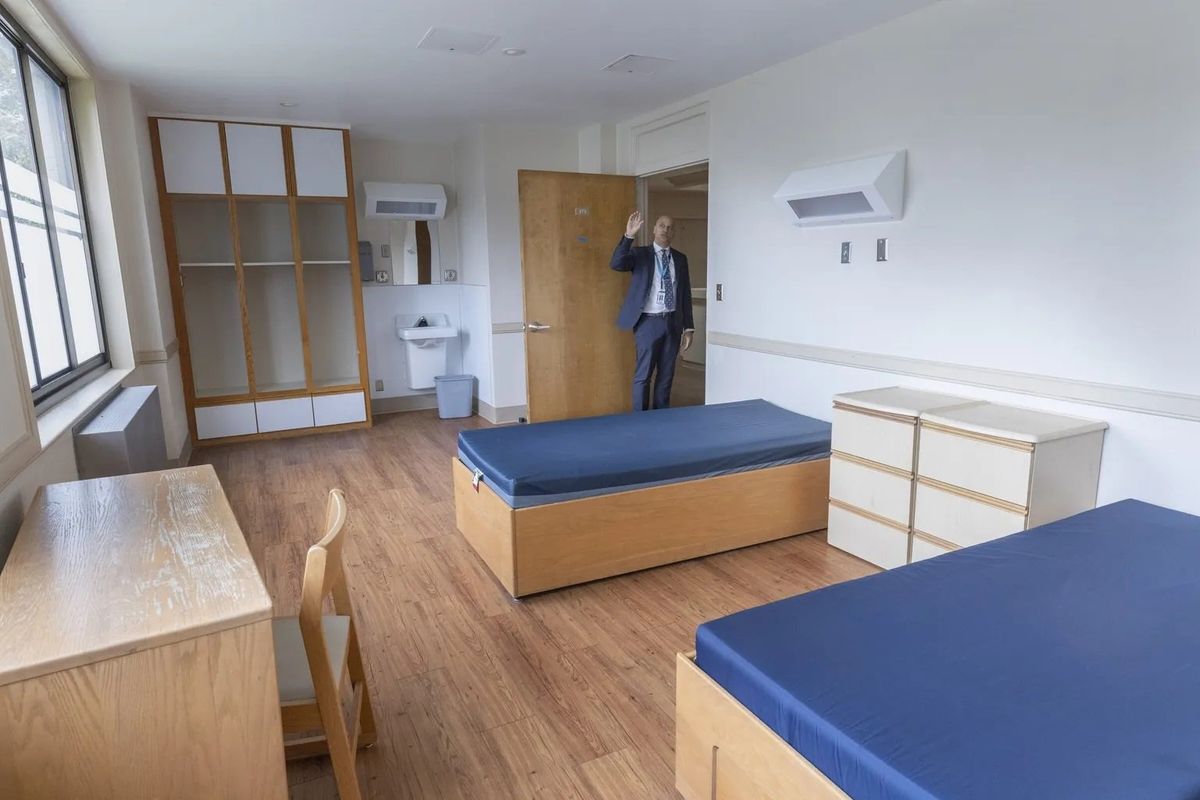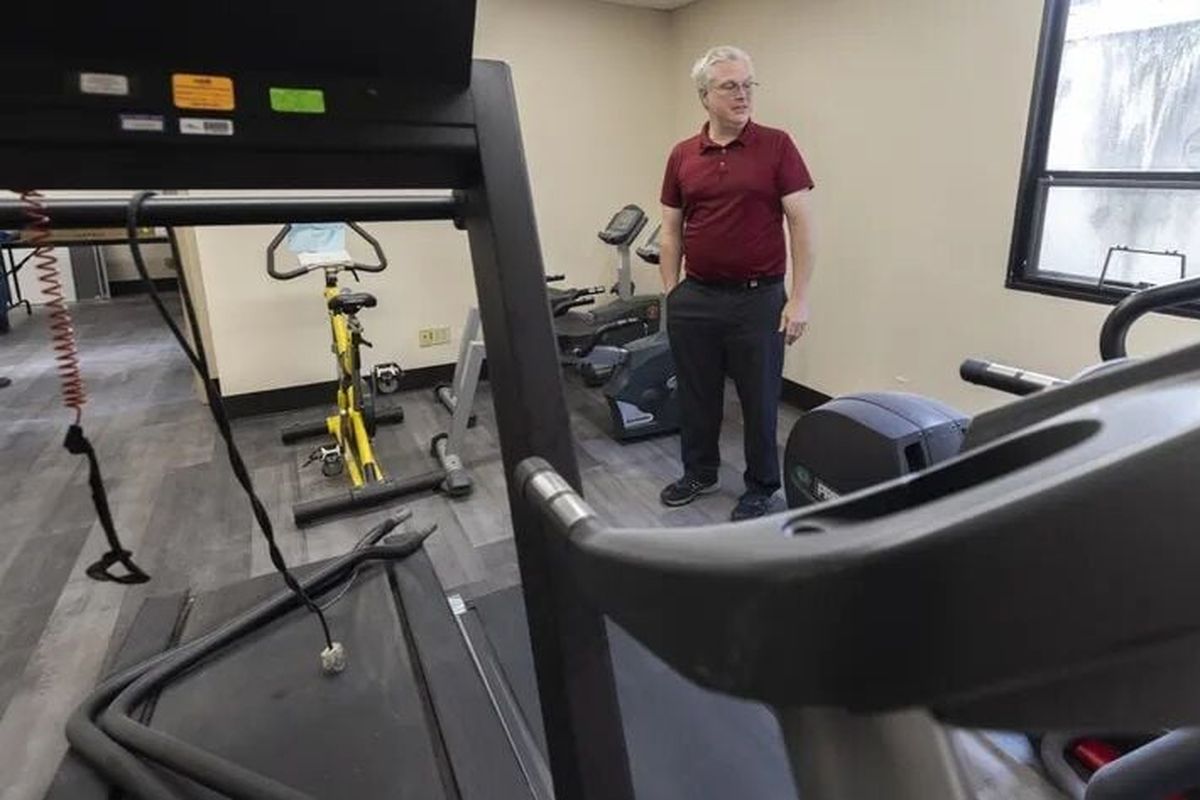How Seattle psychiatric providers are responding as system bursts at the seams
The Tukwila psychiatric facility formerly known as Cascade Behavioral Health Hospital is reopening as Olympic Heritage Behavioral Health and will be operated by the state’s Department of Social and Health Services. Daniel Davis, the CEO of the Olympic Heritage, describes what still needs to be done in one room of the hospital, which is under renovation. (Ellen M. Banner/Seattle Times)
SEATTLE – The labyrinthine hospital campus could easily be mistaken as vacant.
Someone has abandoned a wheelchair in the middle of a waiting room. In deserted wards, dozens of old beds sit empty, some stripped of mattresses. Fallen leaves blanket a wooded courtyard.
Until its July closure, this was the site of Cascade Behavioral Health Hospital, a 137-bed facility in Tukwila and one of Washington’s largest privately owned psychiatric institutions.
But signs of the hospital’s new life are emerging.
Just a few weeks ago, government officials closed a nearly $30 million deal to purchase the building and give it a new name: Olympic Heritage Behavioral Health. On a recent morning, nurses congregated in conference rooms for new employee orientation while kitchen staff poured cranberry juice in preparation for dinner. Two male patients sat quietly in a lounge trimmed with paper Halloween decorations. They’re among 21 long-term psychiatric patients who arrived here in October, the first of an anticipated 112 who will fill the hospital’s corridors by next spring.
Access to mental health care and substance use treatment has contracted severely in Washington in recent years. Government plans to build new community-based treatment centers have faltered. At the same time, several private and nonprofit providers have shrunk their services or closed their facilities entirely. Cascade’s closure alone stripped King County of 13% of its beds for patients in such a severe state that they need to be treated involuntarily.
Now, sudden public investments across Western Washington are rescuing lost behavioral health beds – and adding new ones. There’s a rush to construct mental health facilities across the region – in some cases, renovating or replacing old buildings, and in others, adding brand-new facilities to expand the number of available beds. Voters and state lawmakers have shown their support by investing public dollars to stand up some of the new mental health centers and promoting new laws to encourage more professionals to join the field.
The front lines of mental health care are often frantic emergency departments, crumbling state institutions and jails. As old facilities get reinvigorated and new construction breaks ground, mental health leaders say they’re aiming to bring dignity to an area of the health care world that has historically had little.
“They’re walking into a space where people care for them, where people respect them,” said Tom Sebastian, CEO and president of Compass Health, which is opening a new behavioral health facility in Everett in 2025. “That is designed for the care that they or their loved one need.”
The new developments also are intended to bring more people into the workforce, expand training opportunities for people interested in the field and begin to close gaping holes in a system not built for modern demands.
For now, the expansion of mental health care here is centered on people with the most severe needs: those in a state of crisis, and people who are in such dire states that they need round-the-clock care during weeks- or monthlong stays.
In Kirkland, for instance, a new walk-in crisis center – the first of its kind in King County – is set to open in 2024. And the following year, Compass’ 32-bed crisis stabilization and involuntary treatment center in Everett is scheduled to begin taking patients. At least four additional walk-in crisis centers, including one for youth, are expected to be built by 2030 through a recent King County property tax levy. Levy funds are also expected to restore at least 111 lost residential treatment beds.
Once completed, the bevy of new facilities “will be game changers,” said Susan McLaughlin, behavioral health and recovery division director for King County. But, “building back all the resources that we defunded is way more expensive than had we preserved them in the first place,” she added.
“People are suffering while we’re trying to get these things built as quickly as we can.”
‘A restart’
In a newly opened ward at Olympic Heritage, Daniel Davis, the CEO, points to walls where there used to be holes.
It’s tough to notice – they’ve been patched and painted. Tables and chairs filled with sand – a design that keeps patients from throwing or pushing them – have arrived. As have new bed frames, bolted to patients’ bedroom floors.
One of the most laborious tasks: sourcing ligature-resistant toilets, which keep patients from accidentally or purposefully harming themselves. To get them in time for opening day, the hospital hired a vendor to fly down to California, rent a U-Haul and drive 45 new commodes hundreds of miles north.
From the time the state’s Department of Social and Health Services took over, Davis and staff had six weeks to fix, refurbish and furnish a hospital that hadn’t seen significant updating in many moons.
Cascade, which was owned by Tennessee-based Acadia Healthcare, opened a decade ago; at the time, the company said it anticipated spending about $43 million on the purchase and renovations, but a walk-through in October showed wear and tear requiring hundreds of thousands of dollars in upgrades so far; in all, the state projects spending up to $5 million in renovations this fiscal year. Before that, the building was occupied by Highline Medical Center’s Specialty Campus. Black-and-white photography inside the hospital lobby offers a window into what lay on these grounds nearly a hundred years ago: Riverton Sanatorium, a multiacre campus that admitted patients with tuberculosis.
The hospital will now serve so-called civil conversion patients – people with criminal charges who, because of their possible danger to themselves or others, or because they are “gravely disabled,” are moved to the civil side of the legal system. Most will receive treatment for several months. Some may stay for years.
About 130 people have accepted jobs at Olympic Heritage so far. By the spring, Davis expects to add an additional 470 positions. Standing up a new hospital meant hiring therapists, nurses, doctors, security guards and custodians. Almost half of the new hires are former Cascade employees; several, including Davis, transferred from positions at Western State Hospital
In a wing called the “treatment mall,” baskets of books donated by staff are waiting to be sorted and shelved. Sascha Schaudies, a therapies supervisor and former Western State employee, shows off a room filled with treadmills, an elliptical and stationary bikes. It’s still under construction – workers are measuring and installing plexiglass windows – but Schaudies says he hopes to teach patients tai chi here once renovations are complete.
“There’s just this new energy,” Davis said. “It’s like a restart for many of our staff.”
‘Blank slate’
About 15 miles north of Olympic Heritage, construction crews are putting finishing touches on a new six-floor, 150-bed psychiatric hospital on the UW Medical Center’s Northwest campus.
A close inspection of door handles, furniture and window coverings reveals the level of safety-proofing happening here: Every fixture is smoothed, flattened or curved to prevent patients from hurting themselves.
Wide, sliding barn doors separate patient bedrooms from their private bathrooms. Some of the rooms are small – less than 200 square feet. But natural light streams in through big windows, and palettes of green and blue color the walls.
Unlike medical hospitals, most psychiatric treatment is meant to occur outside the rooms where patients sleep. Inside the new UW facility, a spacious common room gives way to an outdoor patio where long-term patients can get sun or exercise. Group therapy rooms are soundproofed to keep conversations private.
“We had a blank slate,” said Dr. Ryan Kimmel, chief of psychiatry at both campuses of UW Medical Center. “We could think about this in ways that other hospitals are not necessarily able to.”
By April, the hospital will begin accepting patients for two types of neuromodulation treatment – electroconvulsive therapy and transcranial magnetic stimulation – both of which are in short supply in Washington.
It will later open 25 beds for older adults, 75 beds for people on 90- or 180-day civil commitments, and an additional 50 beds for psychiatric patients who also need physical health care. In a nearby building, the hospital is planning to open an additional 14 beds for people seeking care voluntarily.
The hospital will also serve as a training ground for UW’s psychiatry residents and other behavioral health trainees. UW doesn’t currently send residents to Western State Hospital, Kimmel said. The opportunity to work with some of the state’s most severely mentally ill patients – those who are civilly committed for several months – will be a new experience for trainees, he added.
At a time when the behavioral health workforce is shrinking, the hospital will give people new to the field some hope about its direction. “It’s good for the patients and good for workforce development,” he said.
It will show them, he said, that with the right treatment, patients do get better.

